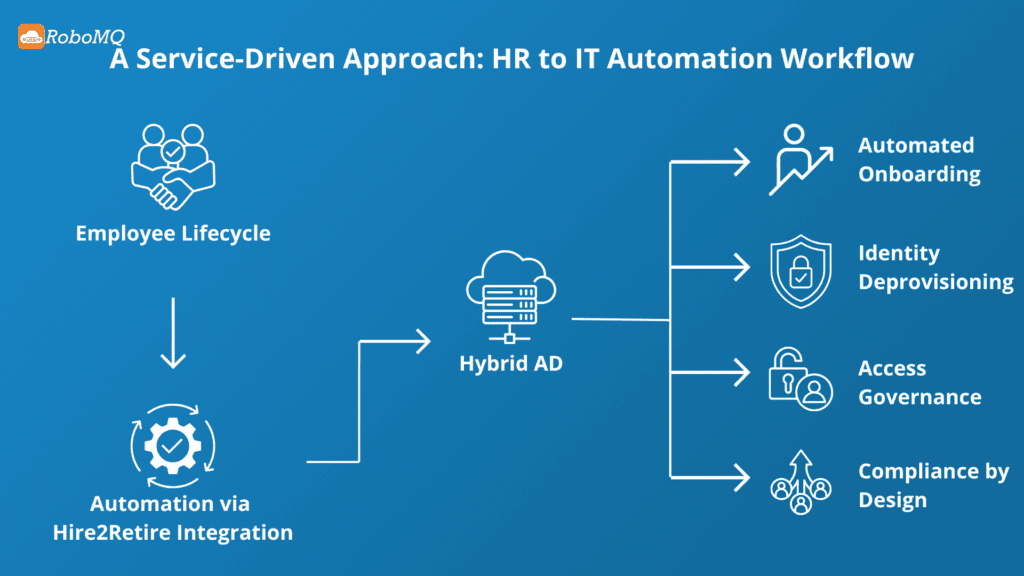In most organizations, Human Resources and IT are typically parallel, but they seldom overlap. Human Resources teams are responsible for onboarding for hiring and managing people, and IT teams are responsible for accounts, permission access, and general security. Both functions are critical to maintaining business performance, but they typically do not operate on the same timelines.
When these two worlds diverge, there is no doubt that the business slows down, new employees cannot log in for several days, on off boarding, the former employee access rights do not get disabled, and general access permissions abide well past an individual’s last day of employment within the organization. Inconveniences like these may seem small, but they introduce and compound frustration, risk, and effort.
Focus workforce management is designed to bridge the people functions of the organization to identity governance through service driven integration. Therefore, instead of a manual approach of constantly updating access and permissions based on the employee lifecycle events, workforce management automates the process and ensures that whichever systems are queried, access and permission associations are triggered instantly, accurately, and every time.
Every employee journey follows a rhythm joining, moving, or leaving. HR captures these moments in the workforce management system, but IT has to reflect them in directories, applications, and access controls. When that happens manually, the delay is inevitable.
And those delays matter.
Without connected systems, HR and IT waste time fixing issues that shouldn’t exist. By applying a focus workforce management mindset, organizations can synchronize data across systems and automate access based on what’s happening in real time.
This shift not only improves efficiency but also strengthens governance ensuring every change in the HR system reflects immediately in the identity layer.
A service-driven integration treats every HR event as a trigger that automatically updates IT systems. Changes occur as part of a workflow that is to be reliable, rules-based and traceable instead of through people sending emails or raising tickets. This is how this works in practice:
Hire2Retire solution is built around this concept. It connects workforce management tools like Workday, SAP SuccessFactors, and ADP with identity platforms like Active Directory and Microsoft Entra ID. Together, they make employee lifecycle automation a natural part of business operations.
BlueAlly, a growing technology company, was dealing with the growing pains of expansion. Their HR team managed employee data in ADP, while IT handled provisioning in Active Directory. Every update whether a new hire, role change, or exit required manual coordination.
It wasn’t just time-consuming; it left gaps in security and caused onboarding delays.
With RoboMQ’s Hire2Retire service-driven integration, BlueAlly automated their employee lifecycle workflows. HR changes now flow instantly into IT systems ensuring that employees have the right access on day one and that access is revoked the moment they leave.
Haffner Energy, a clean-energy organization, faced similar challenges as their workforce scaled. They managed employee information in Paylocity, but provisioning accounts across hybrid Active Directory and Entra ID was still manual. Mistakes and delays were inevitable.
After adopting Hire2Retire, Haffner Energy established a fully automated, service-driven integration between HR and IT. Every change in the HR system whether a promotion, transfer, or exit automatically reflected across directories and apps.
The results were immediate:
In short, Haffner achieved what many aim for simple, secure, and reliable employee lifecycle automation.

Implementing a focus workforce management system is not just for automation it changes the employee experience entirely. Here are some positive outcomes organizations experience:
This is what it means to have true alignment between workforce management and identity governance every change tracked, every permission precise, and every process seamless.
Initial Steps to Start Your Service-Focused Journey If your organization is prepared to transition into an integrated workforce-management model, this is how to begin:
With every step we take, we are getting closer to an automatic, overtly integrated environment where identity management occurs by design, rather than by us just having to remember to take care of it.
The future of workforce management will be about integration not isolation. With hybrid work, remote collaboration and increasingly complex security needs, managing identities manually isn’t going to be sustainable.
Workforce management is the way forward combining HR, IT, and governance into one connected service. It’s about building systems that talk to each other, so employees can do their jobs without friction and organizations stay secure without added effort.
RoboMQ is at the heart of this shift. With solutions like Hire2Retire, companies are streamlining operations, enhancing compliance, and evolving how workforce management intersects with identity governance through a service-enabled integration approach that grows with the business.
It’s a win-win when HR and IT system work in parallel. Employees have quicker access, IT has better control, and HR has cleaner data, all while reducing risk. That’s what focus workforce management is all about: creating harmony between people, systems, and security.
The stories of BlueAlly and Haffner Energy prove it’s not just a concept it’s a reality already driving better business outcomes. And with Hire2Retire, organizations can make this transformation simpler, faster, and smarter.